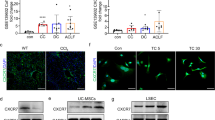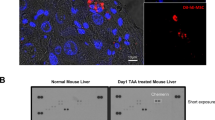Abstract
The role of C-X-C chemokine receptor type 4 (CXCR4) in umbilical mesenchymal stem cells (UMSCs) as therapy for liver disease is ill understood. The aim of the study was to evaluate rat UMSCs (rUMSCs) on CXCR4 expression and homing to injured liver tissue. rUMSCs were isolated from umbilical cords of pregnant rats. Acute liver failure (ALF) models were developed using d-galactosamine. CXCR4 expression induction by serum from rats with ALF (LFS), cytokines, growth factors, and LPS was analyzed. CXCR4 expression was analyzed by RT-PCR, western blot, and flow cytometry. rUMSCs were labeled with carboxyfluorescein and pretreated with LFS to induce CXCR4 expression and were transplanted into ALF rats. Animals were sacrificed 48 h and 1 week after transplantation. Liver-homing rUMSCs were observed under fluorescence microscopy. rUMSCs were successfully isolated, expressing CD90 and CD106, but not CD34 and CD45. mRNA and protein expressions of CXCR4 were strongly up-regulated by LFS and by the mixture of cytokines, stem cell factor, and LPS (CM). Expression of cell surface CXCR4 on rUMSCs in groups treated with LFS (42.37 ± 1.60 %) and CM (40.17 ± 1.78 %) was higher than that in the untreated control group (9.67 ± 1.06 %) (both P < 0.001). At 48 h after transplantation, more rUMSCs pretreated with LFS appeared in the portal area, and migrated to the liver parenchyma after 1 week. LFS strongly induced the surface expression of CXCR4 on rUMSCs. Increasing CXCR4 expression on rUMSCs may enhance their homing ability to injured liver tissue, and may eventually be used for treating liver diseases.




Similar content being viewed by others
References
Allameh A, Kazemnejad S (2012) Safety evaluation of stem cells used for clinical cell therapy in chronic liver diseases; with emphasize on biochemical markers. Clin Biochem 45:385–396. doi:10.1016/j.clinbiochem.2012.01.017
Soto-Gutierrez A, Navarro-Alvarez N, Yagi H, Yarmush ML (2009) Stem cells for liver repopulation. Curr Opin Organ Transplant 14:667–673. doi:10.1097/MOT.0b013e3283328070
Wu YM, Joseph B, Berishvili E, Kumaran V, Gupta S (2008) Hepatocyte transplantation and drug-induced perturbations in liver cell compartments. Hepatology 47:279–287. doi:10.1002/hep.21937
Sato Y, Araki H, Kato J, Nakamura K, Kawano Y, Kobune M, Sato T, Miyanishi K, Takayama T, Takahashi M, Takimoto R, Iyama S, Matsunaga T, Ohtani S, Matsuura A, Hamada H, Niitsu Y (2005) Human mesenchymal stem cells xenografted directly to rat liver are differentiated into human hepatocytes without fusion. Blood 106:756–763. doi:10.1182/blood-2005-02-0572
Wu XB, Tao R (2012) Hepatocyte differentiation of mesenchymal stem cells. Hepatobiliary Pancreat Dis Int 11:360–371
Stock P, Bruckner S, Ebensing S, Hempel M, Dollinger MM, Christ B (2010) The generation of hepatocytes from mesenchymal stem cells and engraftment into murine liver. Nat Protoc 5:617–627. doi:10.1038/nprot.2010.7
Yan JQ, Han T, Zhu ZY (2008) BiologicaI characteristics and differentiation into hepatocyte-like cells of human umbilical cord-derived mesenchymal stem Cells. Shijie Huaren Xiaohua Zazhi 16:1639–1644
Zhao Q, Ren H, Li X, Chen Z, Zhang X, Gong W, Liu Y, Pang T, Han ZC (2009) Differentiation of human umbilical cord mesenchymal stromal cells into low immunogenic hepatocyte-like cells. Cytotherapy 11:414–426. doi:10.1080/14653240902849754
Cho KA, Ju SY, Cho SJ, Jung YJ, Woo SY, Seoh JY, Han HS, Ryu KH (2009) Mesenchymal stem cells showed the highest potential for the regeneration of injured liver tissue compared with other subpopulations of the bone marrow. Cell Biol Int 33:772–777. doi:10.1016/j.cellbi.2009.04.023
Bhakta S, Hong P, Koc O (2006) The surface adhesion molecule CXCR4 stimulates mesenchymal stem cell migration to stromal cell-derived factor-1 in vitro but does not decrease apoptosis under serum deprivation. Cardiovasc Revasc Med 7:19–24. doi:10.1016/j.carrev.2005.10.008
Son BR, Marquez-Curtis LA, Kucia M, Wysoczynski M, Turner AR, Ratajczak J, Ratajczak MZ, Janowska-Wieczorek A (2006) Migration of bone marrow and cord blood mesenchymal stem cells in vitro is regulated by stromal-derived factor-1-CXCR4 and hepatocyte growth factor-c-met axes and involves matrix metalloproteinases. Stem Cells 24:1254–1264. doi:10.1634/stemcells.2005-0271
Honczarenko M, Le Y, Swierkowski M, Ghiran I, Glodek AM, Silberstein LE (2006) Human bone marrow stromal cells express a distinct set of biologically functional chemokine receptors. Stem Cells 24:1030–1041. doi:10.1634/stemcells.2005-0319
Beider K, Nagler A, Wald O, Franitza S, Dagan-Berger M, Wald H, Giladi H, Brocke S, Hanna J, Mandelboim O, Darash-Yahana M, Galun E, Peled A (2003) Involvement of CXCR4 and IL-2 in the homing and retention of human NK and NK T cells to the bone marrow and spleen of NOD/SCID mice. Blood 102:1951–1958. doi:10.1182/blood-2002-10-3293
Shi M, Li J, Liao L, Chen B, Li B, Chen L, Jia H, Zhao RC (2007) Regulation of CXCR4 expression in human mesenchymal stem cells by cytokine treatment: role in homing efficiency in NOD/SCID mice. Haematologica 92:897–904
Lapidot T, Kollet O (2002) The essential roles of the chemokine SDF-1 and its receptor CXCR4 in human stem cell homing and repopulation of transplanted immune-deficient NOD/SCID and NOD/SCID/B2 m(null) mice. Leukemia 16:1992–2003. doi:10.1038/sj.leu.2402684
Kaifi JT, Yekebas EF, Schurr P, Obonyo D, Wachowiak R, Busch P, Heinecke A, Pantel K, Izbicki JR (2005) Tumor-cell homing to lymph nodes and bone marrow and CXCR4 expression in esophageal cancer. J Natl Cancer Inst 97:1840–1847. doi:10.1093/jnci/dji431
Askari AT, Unzek S, Popovic ZB, Goldman CK, Forudi F, Kiedrowski M, Rovner A, Ellis SG, Thomas JD, DiCorleto PE, Topol EJ, Penn MS (2003) Effect of stromal-cell-derived factor 1 on stem-cell homing and tissue regeneration in ischaemic cardiomyopathy. Lancet 362:697–703. doi:10.1016/S0140-6736(03)14232-8
Broxmeyer HE, Orschell CM, Clapp DW, Hangoc G, Cooper S, Plett PA, Liles WC, Li X, Graham-Evans B, Campbell TB, Calandra G, Bridger G, Dale DC, Srour EF (2005) Rapid mobilization of murine and human hematopoietic stem and progenitor cells with AMD3100, a CXCR4 antagonist. J Exp Med 201:1307–1318. doi:10.1084/jem.20041385
Kyriakou C, Rabin N, Pizzey A, Nathwani A, Yong K (2008) Factors that influence short-term homing of human bone marrow-derived mesenchymal stem cells in a xenogeneic animal model. Haematologica 93:1457–1465. doi:10.3324/haematol.12553
Aurich I, Mueller LP, Aurich H, Luetzkendorf J, Tisljar K, Dollinger MM, Schormann W, Walldorf J, Hengstler JG, Fleig WE, Christ B (2007) Functional integration of hepatocytes derived from human mesenchymal stem cells into mouse livers. Gut 56:405–415. doi:10.1136/gut.2005.090050
Vilalta M, Degano IR, Bago J, Gould D, Santos M, Garcia-Arranz M, Ayats R, Fuster C, Chernajovsky Y, Garcia-Olmo D, Rubio N, Blanco J (2008) Biodistribution, long-term survival, and safety of human adipose tissue-derived mesenchymal stem cells transplanted in nude mice by high sensitivity non-invasive bioluminescence imaging. Stem Cells Dev 17:993–1003. doi:10.1089/scd.2007.0201
Ganta C, Chiyo D, Ayuzawa R, Rachakatla R, Pyle M, Andrews G, Weiss M, Tamura M, Troyer D (2009) Rat umbilical cord stem cells completely abolish rat mammary carcinomas with no evidence of metastasis or recurrence 100 days post-tumor cell inoculation. Cancer Res 69:1815–1820. doi:10.1158/0008-5472.CAN-08-2750
Wang S, Zhou C, Qin AL (2012) Abstract #558—The therapeutic potential of rat umbilical mesenchymal stem cells from Warton’s jelly in the treatment of rat chronic pancreatitis and subsequent pancreatic fibrosis induced by DBTC. Gastroenterology 142:S112–S113
Liu KL, Shi BY, Liu DZ, Jin JG, Li HB, Shi YC, Feng K, Xiao L (2010) Isolation and biological characteristics of rat umbilical cord mesenchymal stem cells Modern. Rehabilitation 14:1743–1748
Zhang L, Kang W, Lei Y, Han Q, Zhang G, Lv Y, Li Z, Lou S, Liu Z (2011) Granulocyte colony-stimulating factor treatment ameliorates liver injury and improves survival in rats with d-galactosamine-induced acute liver failure. Toxicol Lett 204:92–99. doi:10.1016/j.toxlet.2011.04.016
Zhang Y, Hu XY, Luo JX, Chen G, Gao SD (2012) Effect of herbs for clearing heat and resolving stasis on liver function and survival in rats with acute liver failure. Shijie Huaren Xiaohua Zazhi 20:1961–1966
Schrepfer S, Deuse T, Reichenspurner H, Fischbein MP, Robbins RC, Pelletier MP (2007) Stem cell transplantation: the lung barrier. Transpl Proc 39:573–576. doi:10.1016/j.transproceed.2006.12.019
Fausto N, Campbell JS (2003) The role of hepatocytes and oval cells in liver regeneration and repopulation. Mech Dev 120:117–130
Yang CC, Shih YH, Ko MH, Hsu SY, Cheng H, Fu YS (2008) Transplantation of human umbilical mesenchymal stem cells from Wharton’s jelly after complete transection of the rat spinal cord. PLoS ONE 3:e3336. doi:10.1371/journal.pone.0003336
Tsai PC, Fu TW, Chen YM, Ko TL, Chen TH, Shih YH, Hung SC, Fu YS (2009) The therapeutic potential of human umbilical mesenchymal stem cells from Wharton’s jelly in the treatment of rat liver fibrosis. Liver Transpl 15:484–495. doi:10.1002/lt.21715
Hong SQ, Zhang HT, You J, Zhang MY, Cai YQ, Jiang XD, Xu RX (2011) Comparison of transdifferentiated and untransdifferentiated human umbilical mesenchymal stem cells in rats after traumatic brain injury. Neurochem Res 36:2391–2400. doi:10.1007/s11064-011-0567-2
Shi LL, Liu FP, Wang DW (2011) Transplantation of human umbilical cord blood mesenchymal stem cells improves survival rates in a rat model of acute hepatic necrosis. Am J Med Sci 342:212–217. doi:10.1097/MAJ.0b013e3182112b90
Sgodda M, Aurich H, Kleist S, Aurich I, Konig S, Dollinger MM, Fleig WE, Christ B (2007) Hepatocyte differentiation of mesenchymal stem cells from rat peritoneal adipose tissue in vitro and in vivo. Exp Cell Res 313:2875–2886. doi:10.1016/j.yexcr.2007.05.020
Christ B, Dollinger MM (2011) The generation of hepatocytes from mesenchymal stem cells and engraftment into the liver. Curr Opin Organ Transpl 16:69–75. doi:10.1097/MOT.0b013e3283424f5b
Kim JW, Kim SY, Park SY, Kim YM, Kim JM, Lee MH, Ryu HM (2004) Mesenchymal progenitor cells in the human umbilical cord. Ann Hematol 83:733–738. doi:10.1007/s00277-004-0918-z
Dominici M, Le Blanc K, Mueller I, Slaper-Cortenbach I, Marini F, Krause D, Deans R, Keating A, Prockop D, Horwitz E (2006) Minimal criteria for defining multipotent mesenchymal stromal cells. The International Society For Cellular Therapy position statement. Cytotherapy 8:315–317. doi:10.1080/14653240600855905
Huang XP, Qin AL, Zhao WF (2009) CXCR4 expression on the surface of bone marrow mesenchymal stem cells in chronic liver failure environment and the influential factors. Zhongguo Zuzhi Gongcheng Yanjiu yu Linchuang Kangfu 13:7885–7888
Lee Y, Jung J, Cho KJ, Lee SK, Park JW, Oh IH, Kim GJ (2013) Increased SCF/c-kit by hypoxia promotes autophagy of human placental chorionic plate-derived mesenchymal stem cells via regulating the phosphorylation of mTOR. J Cell Biochem 114:79–88. doi:10.1002/jcb.24303
Lan RY, Selmi C, Gershwin ME (2008) The regulatory, inflammatory, and T cell programming roles of interleukin-2 (IL-2). J Autoimmun 31:7–12. doi:10.1016/j.jaut.2008.03.002
van der Poll T, Keogh CV, Guirao X, Buurman WA, Kopf M, Lowry SF (1997) Interleukin-6 gene-deficient mice show impaired defense against pneumococcal pneumonia. J Infect Dis 176:439–444
Kant S, Swat W, Zhang S, Zhang ZY, Neel BG, Flavell RA, Davis RJ (2011) TNF-stimulated MAP kinase activation mediated by a Rho family GTPase signaling pathway. Genes Dev 25:2069–2078. doi:10.1101/gad.17224711
van Poll D, Parekkadan B, Cho CH, Berthiaume F, Nahmias Y, Tilles AW, Yarmush ML (2008) Mesenchymal stem cell-derived molecules directly modulate hepatocellular death and regeneration in vitro and in vivo. Hepatology 47:1634–1643. doi:10.1002/hep.22236
Parekkadan B, van Poll D, Suganuma K, Carter EA, Berthiaume F, Tilles AW, Yarmush ML (2007) Mesenchymal stem cell-derived molecules reverse fulminant hepatic failure. PLoS ONE 2:e941. doi:10.1371/journal.pone.0000941
Lee KD, Kuo TK, Whang-Peng J, Chung YF, Lin CT, Chou SH, Chen JR, Chen YP, Lee OK (2004) In vitro hepatic differentiation of human mesenchymal stem cells. Hepatology 40:1275–1284. doi:10.1002/hep.20469
Zhang YN, Lie PC, Wei X (2009) Differentiation of mesenchymal stromal cells derived from umbilical cord Wharton’s jelly into hepatocyte-like cells. Cytotherapy 11:548–558. doi:10.1080/14653240903051533
Acknowledgments
This study was supported by the Social Development Program of Jiangsu Province (BE2010650) and Science of Jiangsu Province (BK20130271).
Author information
Authors and Affiliations
Corresponding author
Electronic supplementary material
Below is the link to the electronic supplementary material.
Rights and permissions
About this article
Cite this article
Deng, C., Qin, A., Zhao, W. et al. Up-regulation of CXCR4 in rat umbilical mesenchymal stem cells induced by serum from rat with acute liver failure promotes stem cells migration to injured liver tissue. Mol Cell Biochem 396, 107–116 (2014). https://doi.org/10.1007/s11010-014-2147-7
Received:
Accepted:
Published:
Issue Date:
DOI: https://doi.org/10.1007/s11010-014-2147-7




